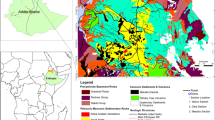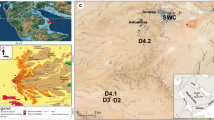Abstract
Stable carbon and oxygen isotope data from mollusc aragonite extracted from sediment cores provide new information on the origin and history of sedimentation in the southwestern area of the central basin of Lake Erie. Sediments infilling the Sandusky subbasin consist of three lithologic units overlying glacial deposits. The lowest of these is a soft gray mud overlain by a shell hash layer containing Sphaerium striatinum fragments. A fluid mud unit caps the shell hash layer and extends upwards to the sediment-water interface. New stable isotope data suggest that the soft gray mud unit is of postglacial, rather than proglacial, origin. These data also suggest that the shell hash layer was derived from erosional winnowing of the underlying soft gray mud layer. This winnowing event may have occurred as a result of the Nipissing flood.
The Pelee-Lorain moraine, which forms the eastern boundary of the Sandusky subbasin, is an elevated area of till capped by a sand deposit that originated as a beach. The presence of both the shell hash layer and relict beach deposit strengthens the interpretation that the Nipissing flood was a critical event in the development of the southwestern area of the central basin of Lake Erie. This event, which returned drainage from the upper lakes to the Lake Erie basin, was a dominant influence on regional stratigraphy, bathymetry, and depositional setting.
Similar content being viewed by others
References
Abell, P. I., 1982. Paleoclimates at Lake Turkana, Kenya, from oxygen isotope ratios of gastropod shells. Nature 297: 321–323.
Abell, P. I., 1985. Oxygen isotope ratios in modern African gastropod shells: a data base for paleoclimatology. Chem. Geol. (Isotope Geoscience Section) 58: 183–193.
Barnett, P. J., 1985. Glacial retreat and lake levels, north central Lake Erie basin, Ontario. In Karrow, P. F. & P. E. Calkin (eds), Quaternary evolution of the Great Lakes. Geol. Assoc. Canada Special Paper 30: 185–194.
Cerling, T. E., J. R. Bowman & J. R. O'Neil, 1988. An isotopic study of a fluviallacustrine sequence: the PlioPleistocene Koobi For a sequence, east Africa. Palaeogeogr., Palaeoclimatol., Palaeoecol. 63: 335–356.
Coakley, J. P. & C. F. M. Lewis, 1985. Postglacial lake levels in the Erie basin. In Karrow P. F. & P. E. Calkin (eds), Quaternary evolution of the Great Lakes, Geol. Assoc. Canada Special Paper 30: 195–212.
Colman, S. M., G. A. Jones, R. M. Forester & D. S. Foster, 1990. Holocene paleoclimatic evidence and sedimentation rates from a core in southwestern Lake Michigan. J. Paleolimnol. 4: 269–284.
Colman, S. M., R. M. Forester, R. L. Reynolds, D. S. Sweetkind, J.W. King, P. Gangemi, G.A. Jones, L. D. Keigwin & D. S. Foster, 1994a. Lake-level history of Lake Michigan for the past 12,000 years: the record from deep lacustrine sediments. J. Great Lakes Res. 20: 73–92.
Colman, S. M., L. D. Keigwin & R. M. Forester, 1994b. Two episodes of meltwater influx from glacial Lake Agassiz into the Lake Michigan basin and their climatic contrasts. Geology 22: 547–550.
Dettman, D. L. & K. C. Lohmann, 1993. Seasonal change in Paleogene surface water δ18O: freshwater bivalves of western North America. In Swart, P.K., K. C. Lohmann, J. McKenzie & S. Savin (eds), Climate change in continental isotopic records. Am. Geophys. Union Geophys. Monogr. 78: 153–163.
Dettman, D. L., 1994. Stable isotope studies of freshwater bivalves (Unionidae) and ostracodes (Podocopida): implications for late Cretaceous / Paleogene and early Holocene paleoclimatology and Paleohydrology of North America, Ph.D. dissertation, University of Michigan, Ann Arbor, Michigan, 215 pp.
Feigl, F., 1937. Qualitative analysis by spot test: Nordemann Publishing Co., New York: 400 pp.
Forester, R. M., S. M. Colman, R. L. Reynolds & L. D. Kegwin, 1994. Lake Michigan' late Quaternary limnological and climate history from ostracode, oxygen isotope, and magnetic usceptibility. J. Great Lakes Res. 20: 93–107.
Fritz, P. & S. Poplawski, 1974. 18O and 13C in the shells of freshwater molluscs and their environments. Earth Planet. Sci. Lett. 24: 91–98.
Fritz, P., T. W. Anderson & C. F. M. Lewis, 1975. Late Quaternary climatic trends and history of Lake Erie from stable isotope studies. Science 190: 267–269.
Fuller, J. A., 1983. Subbottom sediments from the southwestern part of the central basin, Lake Erie. Ohio Journal of Science, 83: 24.
Fuller, J. A., 1996. Sediments of the southwestern corner of the central basin of Lake Erie. U.S. Geol. Survey Open File Report OF 96—21, 13 pp., and 32 pp. appendix and figures.
Fuller, J. A. & E. P. Meisburger, 1982. A simple, shipbased Vibratory corer. J. Sed. Petrol. 52: 642–644.
Fuller, J. A., R. C. Circée & R. N. Oldale, 1995. The geologic framework of the Ohio area of Lake Erie. U.S. Geol. Survey, Open File Report, OF 95—220, 17 pp; 9 fig.
Fuller, J. A., M. J. S. Tevesz & A. L. Spongberg, 1997. Infilling history of the Sandusky subbasin, Lake Erie: sedimentological and isotopic evidence. International Association for Great Lakes Research. 40th Conference. Program & Abstracts: 120–121.
Godwin, A. G., 1985. Stable isotope analyses on postglacial fluvial and terrestrial molluscs from the Kincardine area of southern Ontario: M.S. thesis, University of Waterloo, Waterloo, Ontario, 233 pp.
Hobson, G. D., C. E. Herdendorf & C. F. M. Lewis, 1969. High resolution reflection seismic survey in western Lake Erie. International Association for Great Lakes Research. 12th Conference. Proceedings pp. 210–224.
Keith, M. L., G. M. Anderson & R. Eichler, 1964. Carbon and oxygen isotopic composition of mollusk shells from marine and freshwater environments.Geochim.Cosmochim.Acta 28: 1757–1786.
Kelts, K. & M. Talbot, 1990. Lacustrine carbonates as geochemical archives of environmental change and biotic/abiotic interactions. In Tilzer, M. M. & C. Serruya (eds), Large lakes. Ecological structure and function. Springer-Verlag, Berlin: 288–315.
Lewis, C. F. M., 1969. Late Quaternary history of lake levels in the Huron and Erie basins. International Association for Great Lakes Research. 12th Conference, Proceedings: 250–270.
Lewis, C. F. M. & T. W. Anderson, 1992. Stable isotope (O and C) and pollen trends in eastern Lake Erie, evidence for a locally-induced climatic reversal of Younger Dryas age in the Great Lakes basin. Climate Dynamics 6: 241–250.
McCambridge, C. E., 1997. Stable isotope and sedimentological inferences of the Fairport Harbor offshore deposits, Lake Erie, Ohio. International Association for Great Lakes Research. 40th Conference. Program & Abstracts: 123.
Moore, T. C., Jr., D. K. Rea, L. A. Mayer, C. F. M. Lewis & D.M. Dobson, 1994. Seismic stratigraphy of Lake Huron — Georgian Bay and postglacial lake level history. Can. J. Earth Sci. 31: 1606–1617.
Rea, D. K., T. C. Moore, Jr., T. W. Anderson, C. F. M. Lewis, D. M. Dobson, D. L. Dettman, A. J. Smith & L. A. Mayer, 1994a. Great Lakes paleohydrology: complex interplay of glacial meltwater, lake levels, and sill depths. Geology 22: 1059–1062.
Rea, D. K., T. C. Moore, Jr., C. F. M. Lewis, L. A. Mayer, D. L. Dettman, A. J. Smith & D. M. Dobson, 1994b. Stratigraphy and paleolimnologic record of lower Holocene sediments in northern Lake Huron and Georgian Bay. Can. J. Earth Sci. 31: 1586–1605.
Schelske, C. L. & D. A. Hodell, 1988. An historic record of productivity changes in Lake Ontario inferred from 13C/12C ratios of sedimentary organic and inorganic carbon. Eos 69: 1083.
Schwalb, A., S. M. Locke & W. E. Dean, 1995. Ostracod δ18O and δ13C evidence of Holocene environmental changes in the sediments of two Minnesota lakes. J. Paleolimnol. 14: 281–296.
Sly, P. G., 1976. Lake Erie and its basin. J. Fish. Res. Board Can. 33: 355–370.
Spongberg, A. L., M. J. S. Tevesz & J. A. Fuller, 1997. Organic geochemical evidence for the history of the infilling of the Sandusky subbasin, Lake Erie. International Association for Great Lakes Research. 40th Conference. Program & Abstracts: 127–128.
Stuiver, M., 1968. Oxygen-18 content of atmospheric precipitation during last 11,000 years in the Great Lakes region. Science 162: 994–997.
Stuiver, M., 1970. Oxygen and carbon isotope ratios of freshwater carbonates as climatic indicators. J. Geophys. Res. 75: 5247–5257.
Tevesz, M. J. S., E. Barrera & S. F. Schwelgien, 1996. Seasonal variation in the oxygen isotopic composition of two freshwater bivalves: Sphaerium striatinum and Anodonta grandis. J. Great Lakes Res. 22: 906–916.
Tevesz, M. J. S., J. E. Smith, J. P. Coakley & M. J. Risk, 1997. Stable carbon and oxygen isotope records from Lake Erie sediment cores: mollusc aragonite 4600 BP — 200 BP. J. Great Lakes Res. 23: 307–316.
Williams, S. J., C. H. Carter, E. P. Meisburger & J. A. Fuller, 1980. Sand resources of southern Lake Erie, Conneaut to Toledo, Ohio — a seismic reflection and vibracore study. U.S. Army, Corps of Engineers, Coastal Engineering Research Center, MR 80—10, 83 p.
Williams, S. J. & E. P. Meisburger, 1982. Geological character and mineral resources of south central Lake Erie. U.S. Army Corps of Engineers, Coastal Engineering Research Center, MR 82—9, 62 p.
Author information
Authors and Affiliations
Rights and permissions
About this article
Cite this article
Tevesz, M.J., Spongberg, A.L. & Fuller, J.A. Stable carbon and oxygen isotope record of central Lake Erie sediments. Journal of Paleolimnology 20, 295–305 (1998). https://doi.org/10.1023/A:1007976400698
Issue Date:
DOI: https://doi.org/10.1023/A:1007976400698




